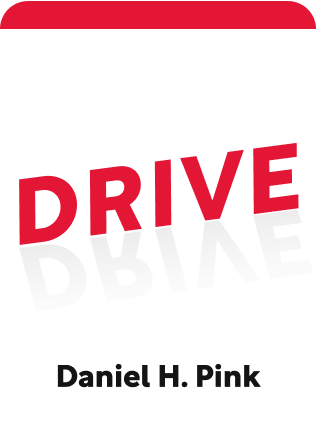

This article is an excerpt from the Shortform book guide to "Drive" by Daniel H. Pink. Shortform has the world's best summaries and analyses of books you should be reading.
Like this article? Sign up for a free trial here .
Are you feeling unmotivated in your job and life? Are you finding your current goals unsatisfying to keep working toward?
Drive by Daniel H. Pink believes your work structure is to blame. Historically, employers have motivated employees through financial rewards and kept workers on a tight leash. These principles worked well when people were primarily working in assembly lines, but today’s creative work demands more: autonomy, mastery, and purpose.
Below is a brief overview of the key points and takeaways.
Rewards and Punishments Are Outdated
Why do people do what they do? What drives behavior?
These are the questions that Drive by Daniel H. Pink attempts to answer. Understanding this is important for guiding your own behavior to achieve your goals, and driving other people’s behavior to meet the organization’s goals.
Starting with the basics: humans, like any other animal, have a foundational desire to survive. Thus we seek food, water, and shelter.
On a higher level, we also seek reward and avoid punishment. Within management, this gave rise to the “carrots and sticks” model – reward the behavior that you want, and punish the behavior you don’t want.
This system worked well in the era of industrialization. Because human work in factories was easy to measure, it was easy to see how work policies changed productivity. Pay a person more per widget they make, and that person will crank out more widgets. These extrinsic (or external) rewards work well for routine tasks.
But in the new information economy, this model is now outdated. The new economy requires thinking skills – creativity, collaboration, long-term thinking. But research suggests extrinsic rewards harm all of these qualities:
- Rewards decrease creativity and narrow focus
- Rewards encourage people to cheat, think short-term, and exploit the incentive system
- Rewards decrease internal motivation to do a good job
- Rewards aren’t enduring – people get used to them, and if you ever take them away, they’ll stop the behavior
The model of extrinsic rewards also doesn’t explain some trends, like people leaving well-paying jobs for lower-paying jobs they enjoy more. It doesn’t explain why unpaid volunteers contribute tirelessly to Wikipedia.
What’s needed is a new, more complete model of human motivation.
Intrinsic Motivation
Intrinsic motivation is a desire to do something for internal satisfaction, not for external rewards.
Imagine a child playing with a toy. The child isn’t being paid to play with it — curiosity and enjoyment are enough.
As an adult, intrinsic motivation increases job performance in the long term. It’s also more enduring – intrinsic motivation doesn’t decay like external rewards do.
Intrinsic motivation is made up of three components:
- Autonomy: having a choice in what you do, and being self-driven
- Mastery: wanting to get more skilled and be recognized for competency
- Purpose: understanding why you’re doing the work. Often centered around helping other people
A bit more about each component:
Autonomy
- There are four major dimensions of autonomy:
- Over tasks: people can choose what they work on
- Over time: people can choose when they work
- Over technique: people can choose how they accomplish the goal
- Over team: people can choose who they work with
- Different people prefer different mixes of these dimensions of autonomy.
- Management guidance: People are naturally wired to be self-driven. Set the direction, trust people to do a good job, and then be hands-off.
Mastery
- People naturally want to get better at skills and be recognized for their skills.
- To make faster progress on the path to mastery, conduct deliberate practice:
- Do challenging tasks that are at the limit of your ability, but not so hard that you will certainly fail.
- Set clear goals for yourself.
- Get fast feedback on how you’re doing and what you can improve.
- Keep doing the above consistently.
- Management guidance: apply the principles of deliberate practice to workers.
- Striving for mastery is painful. There’s no way around it. If it were so easy, we’d all be masters of our craft.
Purpose
- Understanding the purpose and impact of work is motivating.
- A particularly common and especially motivating purpose is helping other people.
- To promote purpose in the workplace:
- Explain why something needs to be done.
- Set company values around deeper ideals like “honor” and “helping the community” rather than steril words like “efficiency” and “value.”
- Allow workers to spend time on socially meaningful projects.
Shortform Caveats
Drive has interesting ideas that seem true on introspection, but the book is very light in cited research, and heavy in anecdotes. The concepts in Drive originated in basic research, but many applications in management are only anecdotes – a certain company instituted 20% time, and lo and behold they started growing! Select anecdotes suffer heavily from bias and are relatively unconvincing.
Furthermore, since its publication, several policies touted by the Drive book have received backlash or even been repealed. For instance, Google’s famous 20% time has been repealed (we’ll explain why later). Netflix offers unlimited vacation days, but workers sometimes complain that it sets unclear expectations that cause people to take less vacation. The policies cited in this book haven’t been sufficiently proven to stand the test of time.
Finally, one of the central premises of the book is that financial incentives don’t do a great job of getting the behavior you want. But a vast volume of research has gone into the opposite, in demonstrating the effect of financial incentives in improving work. Like many management books, Drive doesn’t do a complete enough job of exploring the opposing stance – in this case, surveying the vast literature on incentives.

———End of Preview———
Like what you just read? Read the rest of the world's best book summary and analysis of Daniel H. Pink's "Drive" at Shortform .
Here's what you'll find in our full Drive summary :
- Why you may be feeling unmotivated and unsatisfied at work and in life
- Why financial rewards aren't enough to keep employees motivated anymore
- The three components of intrinsic motivation






